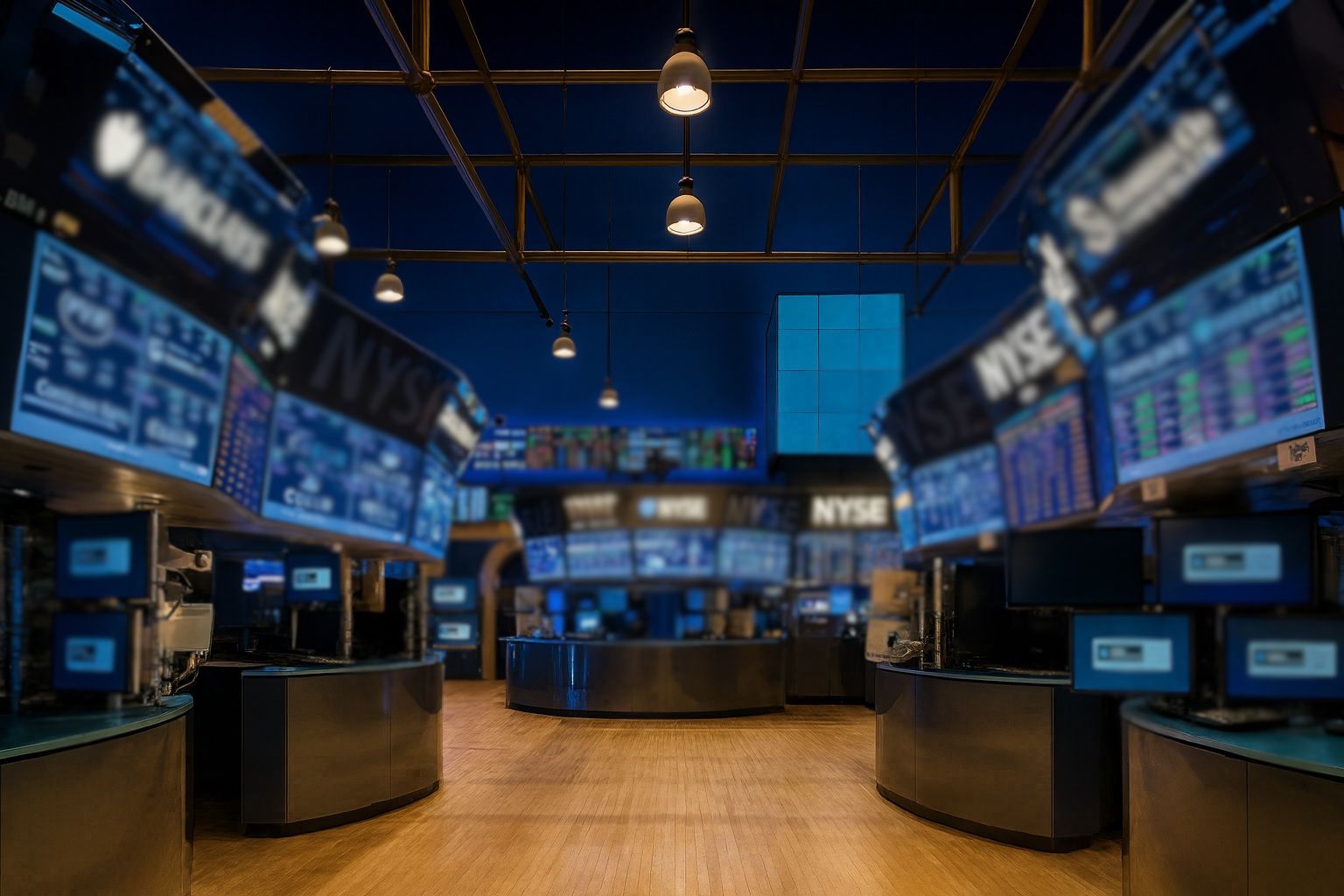- Wall Street Selloff: U.S. stocks plunged Thursday amid credit jitters, with the Dow Jones Industrial Average dropping about 410 points (~0.9%) while the S&P 500 and Nasdaq each fell nearly 1% [1]. Market volatility spiked – the VIX fear index jumped roughly 20% to its highest level since May [2].
- Regional Bank Rout:Regional bank stocks led the decline. Zions Bancorp sank 12% and Western Alliance fell 10.5% after loan-loss disclosures and a fraud lawsuit spooked investors [3]. Jefferies Financial Group also slid about 10%, hurt by its exposure to two recently bankrupt auto lenders [4]. These shocks sparked broader credit market fears, hitting financial shares across the board.
- Safe Havens Surge: Investors rushed into safe havens. Gold prices rocketed to all-time highs, briefly topping $4,379/oz [5] (up ~8% for the week, the biggest weekly jump since 2008’s crisis). U.S. Treasury yields plunged – the 2-year yield hit a three-year low around 3.38% as traders priced in at least two Fed rate cuts by year-end [6]. The 10-year yield likewise fell under 4% [7], reflecting a major flight to safety.
- Global Ripple Effect:Overseas markets sank in sympathy. Europe’s bank index slid 2.7%, dragging the pan-European STOXX 600 down ~1.8% [8]. Major European lenders like Deutsche Bank and Barclays plunged over 5% [9]. In Asia, stocks dropped ~1.4% on Friday, putting regional indexes in the red for the week [10]. Fresh U.S.–China trade tensions – including Beijing’s curbs on rare earth exports – added to the market anxiety [11].
- Warnings of More ‘Cockroaches’: Experts caution that these credit tremors may not be one-offs. JPMorgan CEO Jamie Dimon warned this week that “when you see one cockroach, there’s probably more,” after his bank revealed a $170 million loss on a collapsed lender [12] [13]. IG Markets analyst Tony Sycamore likewise said that while the recent bank issues “seem well contained,” the quick fixes of 2023’s banking crisis have left “a tinderbox for another banking flare-up” [14] – implying further hidden problems could emerge.
Market Selloff Deepens on Credit Fears
A wave of credit-related jitters hit Wall Street, igniting a broad selloff led by financial stocks. On Thursday, the Dow, S&P 500, and Nasdaq all shed nearly 1% of their value [15]. The selloff was concentrated in regional banks, where bad loan news triggered outsized damage. Zions Bancorp disclosed a surprise $50 million loan charge-off, sinking its stock by double-digits, while Western Alliance revealed it is suing a borrower over alleged fraud – news that sent its shares tumbling as well [16]. Even Jefferies, an investment firm, saw its stock slide on concerns about its links to troubled lenders First Brands and Tricolor, which recently went bankrupt [17]. In total, over 80% of S&P 500 companies traded down on the day [18], and the KBW regional bank index plunged 6.5% – a sign of just how hard midsize lenders were hit.
“Where there is smoke, there is often fire.” The speed and severity of the reaction show investors fear these lender problems might not be isolated. “While the recent issues of the two lenders seem well contained, where there is smoke there is often fire, and the remedy of the 2023 crisis has created a tinderbox for another banking flare-up,” warned IG analyst Tony Sycamore [19]. In other words, the emergency measures that halted 2023’s bank panic may have sown the seeds for new problems. Memories of several U.S. bank failures in 2023 – and the government rescues that followed – have left traders hypersensitive to any hint of credit stress. So this week’s combo of surprise loan losses and legal troubles at niche banks sent shockwaves of risk-aversion through the market. The fear gauge (VIX) spiked to its highest level in five months as investors rushed to reduce exposure [20].
Not all sectors suffered equally. Banking and finance stocks were the epicenter, with some bigger banks down more modestly while regionals plunged. By contrast, tech and energy stocks saw milder declines. But the overall mood was clearly risk-off. “Credit concerns have put the market in de-risking mode,” noted one strategist, as even solid earnings reports have been overshadowed by worry about what other problems might be lurking off balance sheets. Analysts say the focus is now on credit quality across the banking system – especially at regional lenders that are more exposed to commercial loans and private credit deals. Until investors are convinced that these issues are contained, sentiment remains fragile, and rallies are being sold off quickly.
Flight to Safety: Gold Soars, Yields Plunge
As stocks sank, investors piled into traditional safe-haven assets. Gold, in particular, has been on a tear. The precious metal vaulted to a record high, trading as high as $4,378.69 per ounce [21]. It’s up roughly 7–8% this week, on track for the biggest weekly gain since the 2008 financial crisis [22]. “It wouldn’t surprise me, frankly, if gold hits $5,000 before it actually stops for air,” said Eren Osman, managing director at Arbuthnot Latham, citing the current rush into safe assets [23]. However, Osman cautioned that such a rapid run-up also brings volatility – gold “could fall 20% in the next month” after this frenetic spike, he noted [24]. For now, though, investors are “more holders than buyers” of gold at these record levels [25] – meaning many prefer to hang on to their bullion as protection, rather than chase prices even higher.
Other havens tell a similar story. U.S. Treasury bonds rallied fiercely as investors sought shelter, sending yields sharply lower. The yield on the 2-year Treasury note – highly sensitive to Federal Reserve policy expectations – plunged to around 3.38%, marking a three-year low [26]. This reflects a dramatic shift in interest rate expectations: markets are now pricing in at least two quarter-point Fed rate cuts by the end of 2025 [27]. In essence, traders believe the Fed will have to ease policy sooner to cushion the economy if credit problems spread. Longer-term 10-year Treasury yields also fell below 4% [28], a notable reversal after weeks of hovering near post-pandemic highs. The U.S. dollar weakened as a result – the dollar index is down about 0.6% this week [29] – while traditional safety currencies like the Japanese yen and Swiss franc each jumped ~1% against the dollar [30]. All of this points to a classic “flight to quality”: investors globally are rotating out of riskier bets (like stocks and corporate loans) and into assets perceived as stable stores of value.
The bond market’s rapid about-face also underscores rising bets that the Fed will intervene if turmoil continues. Just a few weeks ago, investors expected the Fed to hold rates high into next year; now, futures imply multiple cuts. “Safe-haven Treasuries rallied further,” Reuters reported, as traders anticipate the Fed may need to reverse course and loosen policy to address financial strains [31]. For Fed officials, who meet next in early November, this poses a new challenge: they must weigh still-elevated inflation against nascent signs of financial instability. Fed Chair Jerome Powell has said the Fed would act as needed to preserve market functioning – and markets clearly believe him, given how quickly rate-cut expectations have ramped up.
Global Markets Feel the Contagion
Fears over U.S. credit woes spread worldwide by Friday. In Europe, markets opened to a sea of red ink following Wall Street’s lead. The STOXX Europe 600 index fell nearly 2% and bank stocks were hit especially hard, down about 2.7% as a group [32]. Several big European banks saw outsized drops – shares of Deutsche Bank and Barclays plunged over 5% in Friday’s early trading [33]. That carnage echoed the earlier sell-off in Asia’s financial names, suggesting a contagion of confidence: investors from Frankfurt to Hong Kong dumped bank shares on any hint of balance sheet issues. “Tumbling bank shares pulled global stocks lower on Friday,” as Reuters summarized, after the U.S. regional lender jitters “unnerved investors and drove them into safe-haven assets.” [34] [35]
In the Asia-Pacific region, equity markets were already faltering even before the U.S. rout fully hit. MSCI’s Asia-Pacific ex-Japan index dropped about 1.4% by Friday, pushing the region into negative territory for the week [36]. Hong Kong’s Hang Seng and Japan’s Nikkei both fell over 1% as traders digested the twin troubles of U.S. banking stress and geopolitical tensions. Notably, U.S.–China trade frictions have resurfaced as another worry: Beijing on Thursday angrily accused Washington of stoking panic over China’s export controls on rare earth metals [37]. China rebuffed a White House appeal to ease those mineral curbs, a sign of escalating trade tensions that added to market anxiety [38]. The renewed trade sabre-rattling comes on top of existing concerns about tariffs and tech restrictions, reminding investors that the U.S.-China economic conflict is far from resolved. “Sentiment in equities has also taken a hit due to rising trade tensions between China and the United States,” Reuters noted, as the rare-earth dispute hit headlines [39].
There was a glimmer of positive geopolitical news: hopes for an end to the war in Ukraine ticked up. U.S. President Donald Trump announced plans to meet with Russia’s President Putin in Hungary to discuss ending the Ukraine war, in a dramatic diplomatic overture [40]. That prospect helped knock down oil prices to fresh lows. U.S. crude oil fell another 0.5% to around $57.18 a barrel, the cheapest since early summer [41]. Brent crude, the international benchmark, also slid to roughly $60.78 [42]. Oil traders are weighing a potential peace deal that could boost global supply (by lifting sanctions or allowing more exports) against the backdrop of cooling demand as economies slow. For now, crude prices are on track for a third weekly loss, relieving some inflationary pressure but also reflecting expectations of softer global growth ahead. Lower energy costs are a two-edged sword: good for consumers and businesses, but also symptomatic of waning demand. Still, the markets welcomed the idea that two major world powers might dial down a conflict – any reduction in geopolitical risk is a welcome relief in these nervous times.
Outlook: Are More Credit “Cockroaches” Lurking?
The big question for investors now: was this week’s bank scare an isolated blip, or a sign of deeper credit problems to come? Market veterans note that credit cycles turn slowly, then suddenly. After years of easy money and low defaults, cracks are emerging as higher interest rates and economic stress take a toll. Jamie Dimon’s “cockroach” warning encapsulates the worry – that the recent blowups (like subprime auto lender Tricolor and auto-parts firm First Brands) may be just the first bugs to scatter, with more hiding in the shadows [43] [44]. Both of those firms collapsed amid fraud and debt problems, and both had been financed by the lightly regulated private credit “shadow banking” sector [45]. Large banks like JPMorgan had only moderate exposure in those cases (Dimon said JPM’s $170 million Tricolor loss is manageable [46]). But the fear is that other lenders and funds might be nursing bigger losses that haven’t surfaced yet. “When you see one cockroach, there’s probably more,” Dimon cautioned, suggesting investors and regulators should be on alert for additional weak links [47].
For now, financial authorities and bank executives are aiming to reassure the public that this isn’t 2008 all over again. The affected regional banks insist their issues are contained. Western Alliance, for example, said the alleged borrower fraud is a one-off event, and Zions emphasized that its loan losses are modest relative to its overall portfolio. Larger U.S. banks have reported generally solid Q3 results, with ample capital and liquidity. And the Federal Reserve – which was already poised to pause interest rate hikes – now has even more reason to hold back, or even cut rates, if turmoil grows [48]. The fact that bond markets are pricing in Fed rate cuts is effectively a bet that the Fed will ride to the rescue if needed [49]. This safety net mentality could limit the downside for markets: investors expect that if things get truly ugly, policymakers will intervene (with rate relief, liquidity programs, or other tools) to prevent a systemic crisis.
Still, nerves are frayed, and analysts are divided on what comes next. “We’ve had a benign credit environment for so long,” Dimon observed, that some deterioration now is almost inevitable [50]. The question is whether it stays “fairly normal” – a manageable uptick in defaults – or snowballs into something worse [51]. Former IMF chief economist Gita Gopinath recently sounded a warning that today’s market is unusually vulnerable. She pointed out that the massive run-up in U.S. stocks (fueled by excitement over AI and tech) could “amplify the next market downturn”, with trillions in paper wealth at risk of evaporating in a severe correction [52]. In her analysis, factors like tariffs, China’s resource curbs, and geopolitical conflicts have created a fragile backdrop where policymakers have limited room to maneuver [53]. While that is a worst-case scenario, it underscores why the current news – a few worrisome loans going bad – is getting an outsized reaction. Investors have become extremely sensitive to any sign of strain in the financial system.
Going forward, all eyes will be on the earnings reports and guidance from U.S. regional banks and lenders. If those come in better than feared, it could restore confidence. In fact, some analysts note that many regional banks still have healthy capital buffers and liquidity [54], suggesting they can weather this storm. But if more negative surprises emerge – say, another mid-sized lender discloses a big loss, or a private credit fund halts withdrawals – then risk-off sentiment will intensify. The next few weeks will also bring key economic data that could sway the Fed’s stance, and possibly a Fed meeting where officials will address these credit concerns directly.
For now, the mood is one of cautious vigilance. “A few credit one-offs can spark quick selling, even if the hits appear contained,” TS2.tech noted in its market analysis, adding that risk appetite won’t truly return until investors see clearer evidence that credit quality is stabilizing [55]. The hope is that this week’s scare remains just that – a scare, not the start of a broader crisis. Financial markets have bounced back from similar episodes in 2023 and earlier in 2025 when fears proved overblown. If the “cockroaches” of bad credit stay few and far between, stocks could find their footing again and end the year on a stronger note. But if more bugs crawl out of hiding, the rest of 2025 could bring a lot more volatility. As one Wall Street adage puts it, “Markets take the stairs up and the elevator down.” After a long climb, investors are bracing in case there’s another sudden elevator drop ahead – hoping it’s not a plunge into darkness, but prepared for a bumpy ride until the all-clear sounds.
Sources: Reuters [56] [57] [58]; TS2.tech [59] [60]; The Guardian [61] [62]; Reuters (Global Markets Wrap) [63] [64].
References
1. ts2.tech, 2. ts2.tech, 3. ts2.tech, 4. ts2.tech, 5. www.reuters.com, 6. www.reuters.com, 7. ts2.tech, 8. www.reuters.com, 9. www.reuters.com, 10. www.reuters.com, 11. www.reuters.com, 12. www.theguardian.com, 13. www.theguardian.com, 14. www.reuters.com, 15. ts2.tech, 16. ts2.tech, 17. ts2.tech, 18. ts2.tech, 19. www.reuters.com, 20. ts2.tech, 21. www.reuters.com, 22. www.reuters.com, 23. www.reuters.com, 24. www.reuters.com, 25. www.reuters.com, 26. www.reuters.com, 27. www.reuters.com, 28. ts2.tech, 29. www.reuters.com, 30. www.reuters.com, 31. www.reuters.com, 32. www.reuters.com, 33. www.reuters.com, 34. www.reuters.com, 35. www.reuters.com, 36. www.reuters.com, 37. www.reuters.com, 38. www.reuters.com, 39. www.reuters.com, 40. www.reuters.com, 41. www.reuters.com, 42. www.reuters.com, 43. www.theguardian.com, 44. www.theguardian.com, 45. www.theguardian.com, 46. www.theguardian.com, 47. www.theguardian.com, 48. www.reuters.com, 49. www.reuters.com, 50. www.theguardian.com, 51. www.theguardian.com, 52. ts2.tech, 53. ts2.tech, 54. ts2.tech, 55. ts2.tech, 56. www.reuters.com, 57. www.reuters.com, 58. www.reuters.com, 59. ts2.tech, 60. ts2.tech, 61. www.theguardian.com, 62. www.theguardian.com, 63. www.reuters.com, 64. www.reuters.com








